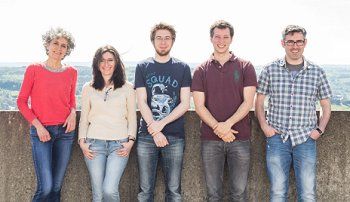Viruses cause leukemia
Press release (23/05/2017)
Viruses hijack cancer genes to cause leukemia
Brussels, 23 May 2017 – A team of researchers led by Anne Van den Broeke (Institut Jules Bordet - University of Brussels and GIGA-University of Liège) has uncovered a novel mechanism by which viruses cause leukemia. These new findings, published on 23rd May in Nature Communications, could be key to the understanding of virus induced cancers and the development of targeted therapeutic strategies for a very aggressive type of leukemia.

Studying a bovine virus to tackle human leukemia
Approximately 12% of human cancers worldwide are attributed to viral infection. Human T-cell leukaemia Virus-1 (HTLV-1), the first oncogenic retrovirus discovered in human, infects an estimated 20 million people worldwide and causes adult T cell leukemia (ATL), an aggressive leukemia with an extremely poor prognosis. The closely related Bovine Leukemia Virus (BLV) produces a very similar disease in cattle and sheep, with the latter providing a unique outbred animal model for cancer research.
It has been generally assumed that leukemia development is dependent on the production of cancer-promoting agents by the virus yet is independent of the location of the virus within the genome of the cancer cell. The research team was the first to discover that, contrary to the prevailing dogma, HTLV-1 and BLV do not integrate randomly in the host genome but rather in the vicinity of genes involved in cancer (“cancer drivers”). The most surprising observation was that these cancer drivers were systematically positioned upstream relative to the virus rather than downstream as would be expected mechanistically. The team further demonstrated the perturbation of the corresponding genes via interactions with viral “antisense” transcripts (viral factors synthesized in the opposite orientation relative to the classical viral products), revealing a novel mechanism by which oncogenic viruses and antisense transcription contribute to cancer development.
Using novel next generation sequencing (NGS) methods, the researchers further showed that, in both humans and animals, these perturbations are present long before the leukemia becomes aggressive. The screen for finding the precise viral insertion spots in the sheep genome revealed a list of several hundreds of genes, a third of which have not been previously reported in cancer, thus providing a treasure trove of new candidate cancer driver genes for further investigations.
The study, carried out in collaboration with scientists of the Necker University hospital in Paris and the VIDO/Intervac research institute of the University of Saskatchewan in Canada, is the result of interdisciplinary research that combines oncology, viral pathogenesis and animal genomics.
New avenues for cancer research and clinical applications
Having demonstrated the sequestration of host cancer drivers by the virus and the unexpected role of viral antisense transcripts in this process, the team now hopes that further research will be able to identify specific inhibitors as a basis for the future development of targeted therapies. Finally, the NGS method developed in this study can now be applied to monitor ATL patients, enabling better prediction of relapse and providing clinicians with a molecular tool to evaluate response to treatment.
Reference
Nicolas Rosewick, Keith Durkin, Ambroise Marçais, Maria Artesi, Vincent Hahaut, Philip Griebel, Natasa Arsic, Véronique Avettand-Fenoel, Arsène Burny, Carole Charlier, Olivier Hermine, Michel Georges & Anne Van den Broeke (2017) Cis-perturbation of cancer drivers by the HTLV-1/BLV proviruses is an early determinant of leukemogenesis, Nature Communications, doi: 10.1038/NCOMMS15264
Senior investigators
Dr Anne Van den Broeke (Institut Jules Bordet and GIGA) and Prof Michel Georges (GIGA).
Laboratory of Experimental Hematology, Institut Jules Bordet, Université Libre de Bruxelles (ULB), Boulevard de Waterloo 121, 1000 Brussels, Belgium.
Unit of Animal Genomics, GIGA-R, Université de Liège, Avenue de l’Hôpital 11, B34, 4000 Liège, Belgium.
Research funding
This work was supported by the Fonds de la Recherche Scientifique (FRS), les Amis de l’Institut Bordet, Télévie, the International Brachet Stiftung (IBS) and the Fondation Lambeau Marteaux.
International collaborations
Hôpital universitaire Necker, Paris, France – Dr Olivier Hermine and Dr Ambroise Marçais VIDO/Intervac, University of Saskatchewan, Saskatoon, Canada – Dr Philip Griebel
Enclosed
· Photograph of the research team headed by Anne Van den Broeke
· Scientific diagram explaining the new model of viral carcinogenesis (see attached PDF for image and
caption)
For more information:
Dr Anne Van den Broeke: anne.vandenbroeke@bordet.be
Prof Michel Georges: michel.georges@ulg.ac.be
Contacts Presse - Institut Jules Bordet
Institut Jules Bordet
Ariane van de Werve
Tel: +32 2 541 31 39
GSM : +32.48617 33 26
E-mail : ariane.vandewerve@bordet.be
www.bordet.be
University of Liège
Didier Moreau
Tel +32 4 366 52 17
GSM : +32 494 572 530
E-mail : dmoreau@ulg.ac.be